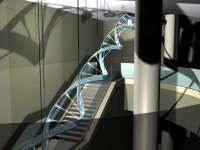Project for UCLA Hospital, Los Angeles, California
© Nobuho Nagasawa
Concept:
All living things contain DNA. The main role of DNA in the cell is the storage of information. It is often compared to a blueprint, since it contains the instructions to construct other components of the cell. Intrinsic to the support of life processes, artist’s goal for the UCLA Hospital art plan is to visually represent the DNA molecule in the form of a stimulating information device. Recordings of the artist’s heartbeat will be reflected in the actual light pulsations coursing through the fiber-optic cables that comprise the sculpture.
Location and Size:
The DNA sculpture will be located at the front entrance of the grand staircase facing the people entering the hospital. The double helix will be 3’-6” feet in diameter and 48’-3 3/8” feet long. The sculpture will compliment the space of the entrance, hanging dynamically in a non-intrusive way between the staircase and the structural columns.
Materials:
The sculpture consists of three parts—Frame, Body, and Strings. The frame is made of stainless steel or aluminum structural members to achieve a light weight and rigid structure. The hanging height will be physically out of reach, yet near enough to create an intimate presence. The structural frame is covered by optical fiber which is suitable for both interior and exhibition applications due to the light weight, durability, and higher fire rating. The optical fiber will be gathered into four 150W Metal Halide lamp illuminators housed both in the first floor ceiling level and behind the soffit above the landing. The recorded sound of the artist’s heartbeat will generate the light to pulse slowly to create a stimulating visual metaphors. The DNA “Ladder” will be made out of heat resistant glass, that are commonly used in the science laboratory and hospitals. The entire DNA sculpture will be hung by aircraft cables attached to the ceiling.
The hospital is invoked as a place of healing and sustaining life, represented by the visual heartbeat.
Project for UCLA Hospital, Los Angeles, California
© Nobuho Nagasawa
Concept:
All living things contain DNA. The main role of DNA in the cell is the storage of information. It is often compared to a blueprint, since it contains the instructions to construct other components of the cell. Intrinsic to the support of life processes, artist’s goal for the UCLA Hospital art plan is to visually represent the DNA molecule in the form of a stimulating information device. Recordings of the artist’s heartbeat will be reflected in the actual light pulsations coursing through the fiber-optic cables that comprise the sculpture.
Location and Size:
The DNA sculpture will be located at the front entrance of the grand staircase facing the people entering the hospital. The double helix will be 3’-6” feet in diameter and 48’-3 3/8” feet long. The sculpture will compliment the space of the entrance, hanging dynamically in a non-intrusive way between the staircase and the structural columns.
Materials:
The sculpture consists of three parts—Frame, Body, and Strings. The frame is made of stainless steel or aluminum structural members to achieve a light weight and rigid structure. The hanging height will be physically out of reach, yet near enough to create an intimate presence. The structural frame is covered by optical fiber which is suitable for both interior and exhibition applications due to the light weight, durability, and higher fire rating. The optical fiber will be gathered into four 150W Metal Halide lamp illuminators housed both in the first floor ceiling level and behind the soffit above the landing. The recorded sound of the artist’s heartbeat will generate the light to pulse slowly to create a stimulating visual metaphors. The DNA “Ladder” will be made out of heat resistant glass, that are commonly used in the science laboratory and hospitals. The entire DNA sculpture will be hung by aircraft cables attached to the ceiling.
The hospital is invoked as a place of healing and sustaining life, represented by the visual heartbeat.

